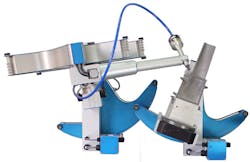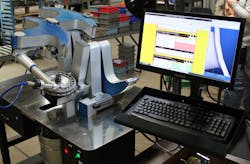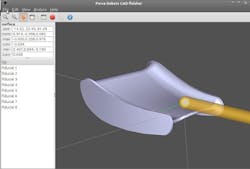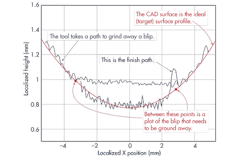Soft-Touch Robots Nix Complicated Kinematics and Delicate Force/Torque Sensors with Software to Improve Complex Machining
Polishing, machining, and grinding are now easier with soft robots using direct-drive low-inertia links instead of series-elastic actuators or kinematics fitted with force/torque sensors. Touch Robots from start-up company Force Robots LLC, Cleveland, are said to be safe around people and carefully apply forces to workpieces for smooth finishes. They also measure surface contours on parts to autonomously generate toolpaths for shaping parts to CAD-model specifications.
The first unit has been installed in a Cleveland-area casting plant and removes excess material in hard-to-reach areas on nickel-alloy jet-engine parts. This is a tough application for three reasons. First, different sections need different amounts of material removed. Second, there’s no easily referenced part surface on which to home the robot tool. Finally, gas-path surfaces on finished turbines must be perfectly smooth, even if their absolute dimensions vary.
The 100-kg Touch Robot shapes and smooths the tough, precision-cast parts with an end tool fixed to an arm that has three cable-drive transmissions driven by brushless motors. In the mechanisms, tension cables loop around a driveshaft capstan, lie along the “wings” of an adjacent arc-shaped linkage, and attach at the wing tips. When a motor drives the capstan, the cables transmit torque to the arc-shaped linkage, which engages another cable-driven joint. A compact actuator from Harmonic Drive LLC, Peabody, Mass., drives the fourth tool axis.
The arm coordinates moves with a two-axis part positioner that mounts to a 1.2 × 0.8-m worktable. Splitting the machine’s degrees-of-freedom between mechanisms preserves the deft touch of the end effector while letting the machine manipulate heavy nickel-alloy castings. Speeds are also different for the two machine parts: The first three-arm linkages reach speeds to 300°/sec, and the fourth moves to 360°/sec; the worktable positioner axes move at speeds to 250°/sec and 1,500°/sec.
Turbine-blade geometry varies considerably, but casting artifacts generally consist of die lines, pin blips, and core exit flash. So controls use parametric motion paths, compliance settings, and success metrics to drive different material-removal protocols. Working by force simplifies programming. Waypoints to establish machining poses and transitioning points are taught by manually moving the robot to the desired position. Software finds finishing-feature locations on an annotated CAD model and maintains the desired tool angle on curved surfaces.
Through simple angle sensors, robot controls measure the actual surface shape, compare it to a reference CAD model, identify sections with excess material, and move the arm to work key surfaces.
Working by force also lets the robot match surface shape to the target shape, even as the cutting tool dulls. Final workpiece accuracy is within a few tenths of a millimeter, thanks to the accuracy of the robot’s differential kinematics, positioning repeatability to ± 0.010 mm, and the way the tool serves as both measurement probe and material remover.
The Touch Robot is also safe around humans. The arm can’t reach beyond the tabletop (500 mm in any direction); low motor-supply voltage (24 Vdc) limits speed; and a person can easily overpower the arm’s modest force capacity and low-friction back-drivable joints. (In contrast, plants must usually cage conventional robots.) The safe nature of the Touch Robot lets operators use it like a laborsaving appliance — for example, tasking it with removing the heaviest and most difficult-to-reach material on a casting-finishing job so operators can devote more time to fine-finishing and inspection.
Resources: Force Robots LLC | (216) 881-8360
About the Author
Elisabeth Eitel
Elisabeth Eitel was a Senior Editor at Machine Design magazine until 2014. She has a B.S. in Mechanical Engineering from Fenn College at Cleveland State University.




